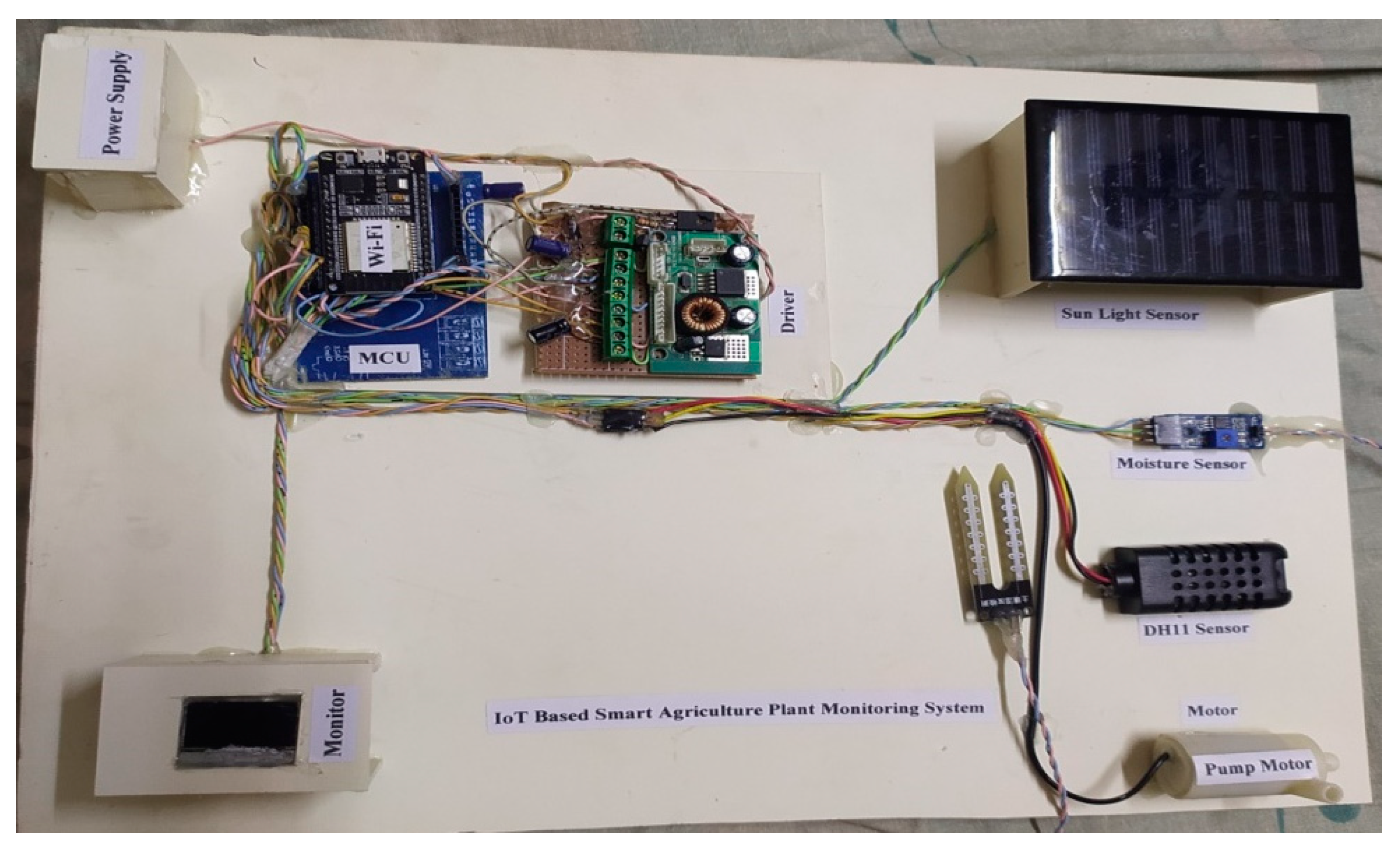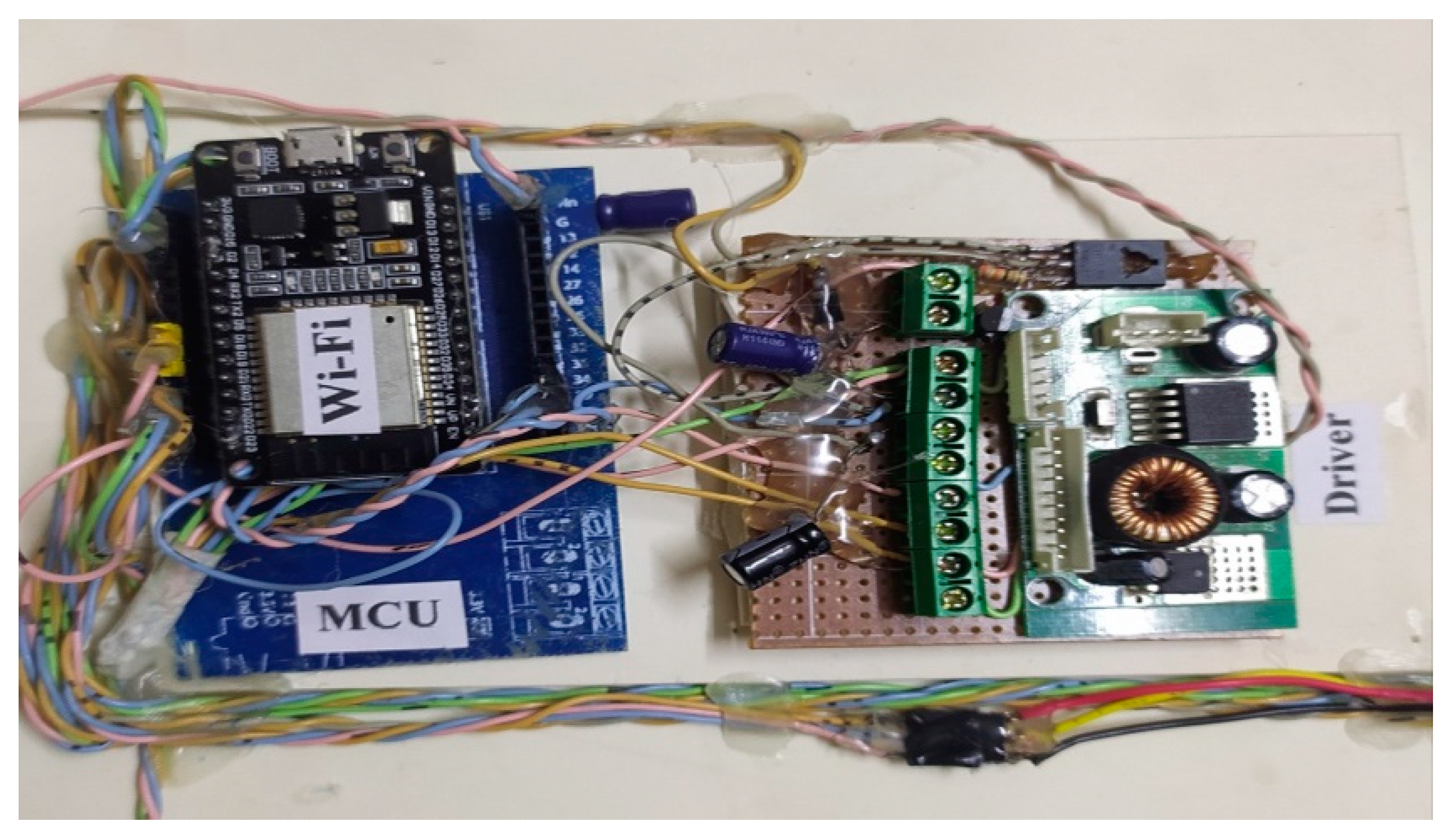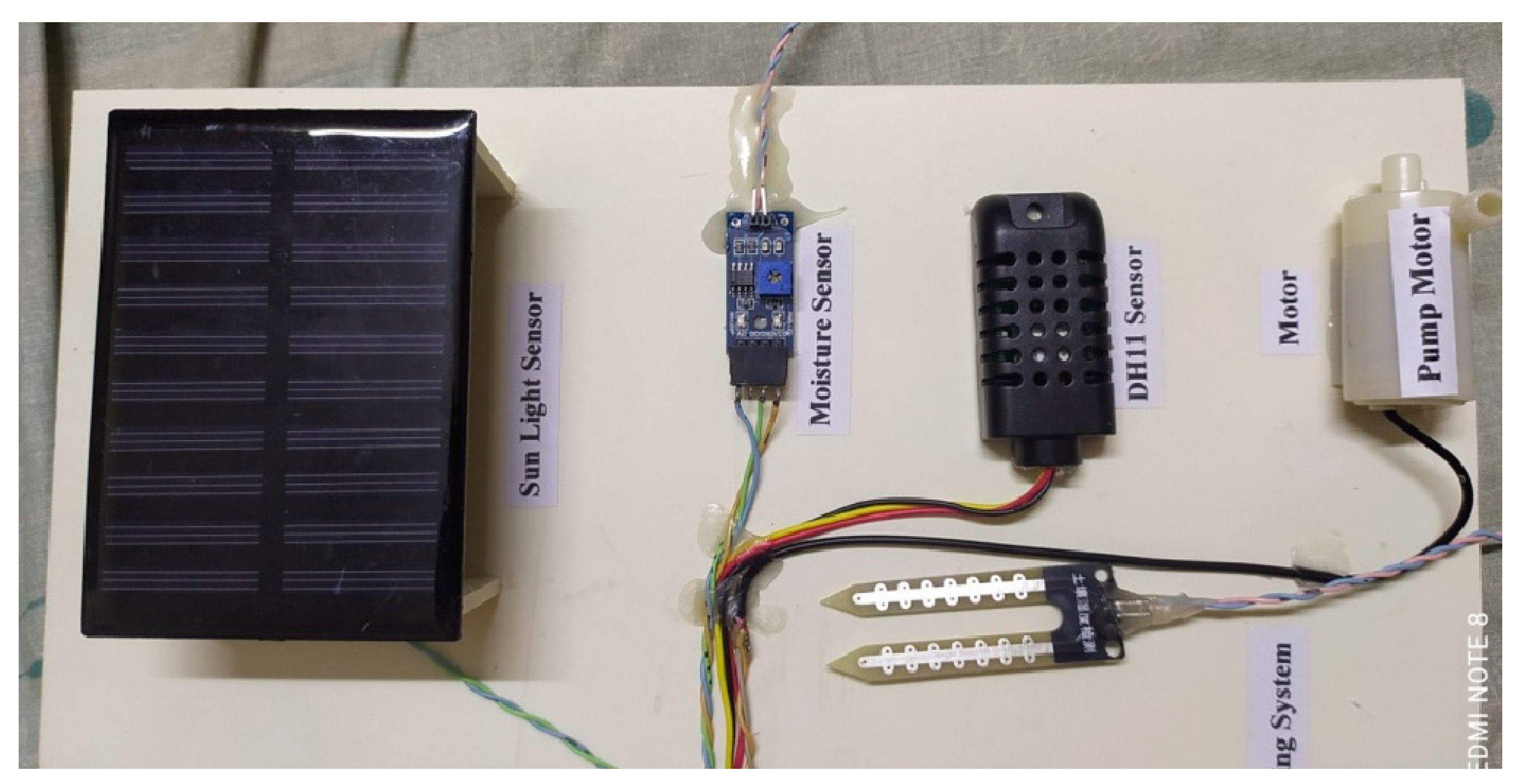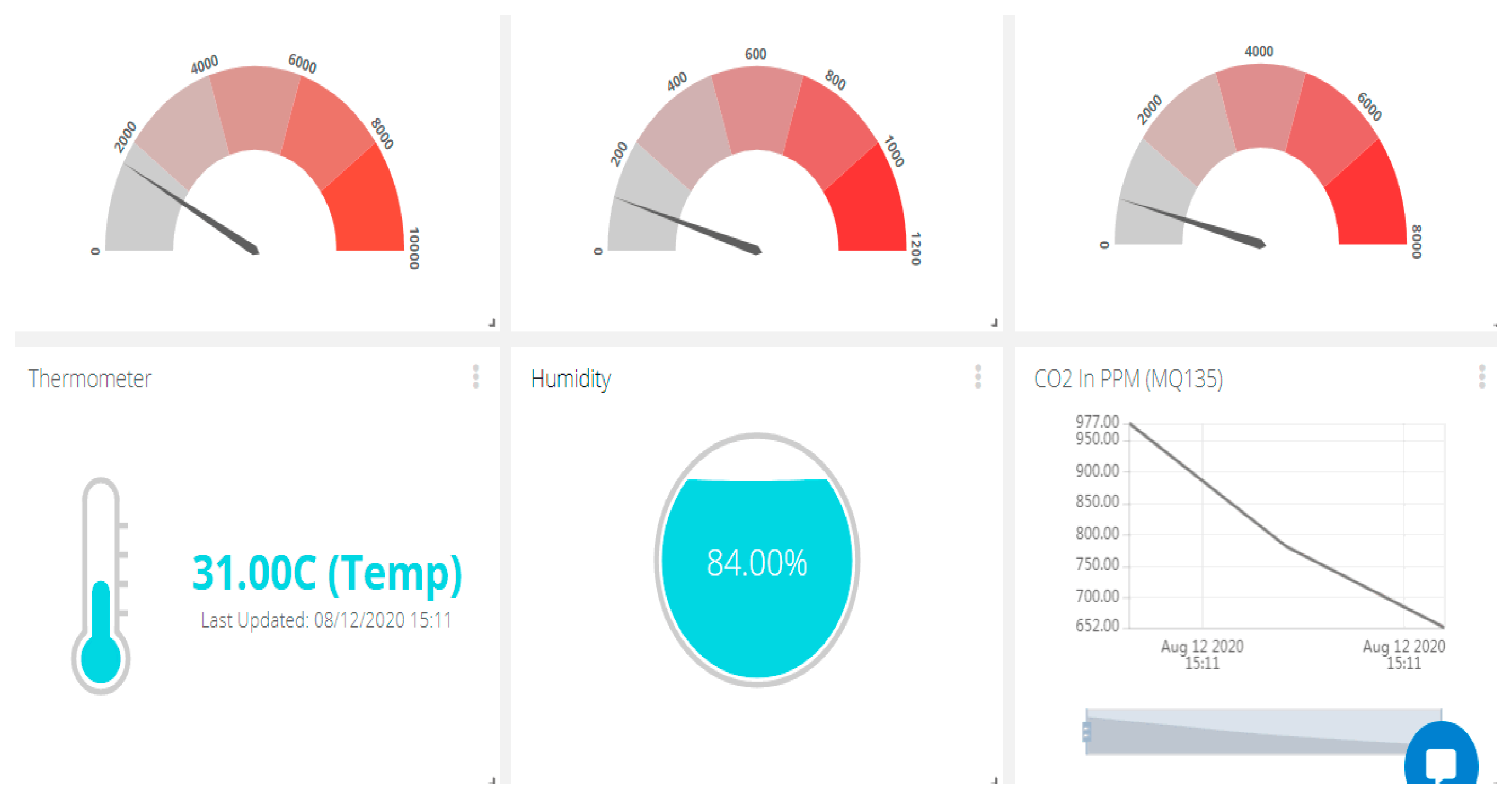Internet of Things (IoT)-Based Smart Agriculture Irrigation and Monitoring System Using Ubidots Server †
Abstract
1. Introduction
2. Proposed System
- Sensor data acquisition: The sensor is connected to the ESP32 microcontroller via a DHT11 temperature, humidity, soil moisture, and rain detection sensor.
- Wireless data transmission: Sensor data are wirelessly delivered to the Ubidots server (using the ESP32 Wi-Fi module).
- Data processing and decision making: Data processing is the task of comparing various sensor data received from the field to previously established threshold values. If the soil moisture reading drops below the threshold, the motor will turn on automatically, and vice versa. The farmer can even activate the motor from his mobile device or laptop via the Ubidots server.
- Irrigation system automation: Upon receiving control from a server, the irrigation system becomes automated. Control from a web server is transferred via relays to an Arduino microcontroller, which powers electrical switches. Relays can be used to regulate circuits with low-power signals.
- Server application: The server is intended to monitor the field and crops from anywhere via an internet connection. The ESP32 microcontroller is utilized for controlling and communicating with the server.
2.1. Ubidots Server
2.2. Cloud Storage
3. Experimental Results and Analysis
4. Conclusions
Author Contributions
Funding
Institutional Review Board Statement
Informed Consent Statement
Data Availability Statement
Conflicts of Interest
References
- Available online: https://www.worldbank.org/en/results/2016/10/07/bangladesh-growing-economy-through-advances-in-agriculture (accessed on 25 October 2021).
- Available online: https://www.un.org/development/desa/pd/sites/www.un.org.development.desa.pd/files/files/documents/2020/Jan/un_2017_world_population_prospects-2017_revision_databooklet.pdf (accessed on 25 November 2021).
- Nisha, G.; Megala, J. Wireless Sensor Network Based Automated Irrigation and Crop Field Monitoring System. In Proceedings of the 2014 Sixth International Conference on Advanced, Chennai, India, 17–19 December 2014. [Google Scholar]
- FAO. The State of Food and Agriculture 2020. In Overcoming Water Challenges in Agriculture; FAO: Rome, Italy, 2020. [Google Scholar]
- Veeramanikandasamy, T.; Sambath, K.; Rajendran, K.; Sangeetha, D. Remote Monitoring and Closed Loop Control System for Social Modernization in Agricultural System Using GSM and Zigbee Technology. In Proceedings of the 2019 International Conference on Advances in Electrical Engineering (ICAEE), Vellore, India, 7–9 March 2019; pp. 1–4. [Google Scholar]
- Veerachamy, R.; Ramalakshmi, R.; Kavin, B.P.; Hussain, I.; Almaliki, A.H.; Almaliki, A.A.; Elnaggar, A.Y.; Hussein, E.E. Exploiting IoT and its enabled technologies for irrigation needs in agriculture. Water 2022, 14, 719. [Google Scholar] [CrossRef]
- Kamienski, C.; Jentsch, M.; Eisenhauer, M.; Kiljander, J.; Ferrera, E.; Rosengren, P.; Sadok, D. Application Development for the Internet of Things: A Context-Aware Mixed Criticality Systems Development Platform. Comput. Commun. 2017, 104, 1–16. [Google Scholar] [CrossRef]
- Mohiuddin, M.; Islam, M.A.; Enan, A. Air Quality Monitoring in Chittagong by a Low Cost IoT Based Air Quality Monitoring System. EDU J. Comput. Electr. Eng. 2021, 2, 8–15. [Google Scholar] [CrossRef]
- Sahu, C.K.; Behera, P. A Low Cost Smart Irrigation Control System. In Proceedings of the IEEE sponsored 2nd International Conference on Electronics and Communication System (ICECS2015), Coimbatore, India, 26–27 February 2015. [Google Scholar]
- Kabir, M.H.; Kabir, M.A.; Islam, M.S.; Mortuza, M.G.; Mohiuddin, M. Performance Analysis of Mesh Based Enterprise Network Using RIP, EIGRP and OSPF Routing Protocols. Eng. Proc. 2021, 10, 47. [Google Scholar] [CrossRef]
- Pawar, S.B.; Rajput, P.; Shaikh, A. IoT Based Agriculture Monitoring and Smart Irrigation System Using Raspberry Pi. Int. Res. J. Eng. Technol. 2018, 5, 1163–1166. [Google Scholar]
- Elijah, O.; Rahman, T.A.; Orikumhi, I.; Leow, C.Y.; Hindia, M.N. An Overview of Internet of Things (IoT) and Data Analytics in Agriculture: Benefits and Challenges. IEEE Internet Things J. 2018, 5, 3758–3773. [Google Scholar] [CrossRef]
- Mohiuddin, M.; Islam, M.S.; Uddin, J. Feature Optimization for Machine Learning Based Bearing Fault Classification. Indones. J. Electr. Eng. Inform. 2024, 12, 3. [Google Scholar] [CrossRef]
- Yan-e, D. Design of Intelligent Agriculture Management Information System Based on IoT. In Proceedings of the Fourth International Conference on Intelligent, Computation Technology and Automation 2011, Shenzhen, China, 28–29 March 2011; Volume 1, pp. 1045–1049. [Google Scholar]
- Nandurkar, S.R.; Thool, V.R. Design and Development Precision Agriculture System Using Wireless Sensor Network. In Proceedings of the IEEE International Conference on Automation, Control, Energy and Systems (ACES), Adisaptagram, India, 1–2 February 2014. [Google Scholar]
- Gutiérrez, J.; Villa-Medina, J.F.; Nieto-Garibay, A.; Porta-Gándara, M.Á. Automated Irrigation System Using a Wireless Sensor Network and GPRS Module. IEEE Trans. Instrum. Meas. 2013, 63, 166–176. [Google Scholar] [CrossRef]






Disclaimer/Publisher’s Note: The statements, opinions and data contained in all publications are solely those of the individual author(s) and contributor(s) and not of MDPI and/or the editor(s). MDPI and/or the editor(s) disclaim responsibility for any injury to people or property resulting from any ideas, methods, instructions or products referred to in the content. |
© 2024 by the authors. Licensee MDPI, Basel, Switzerland. This article is an open access article distributed under the terms and conditions of the Creative Commons Attribution (CC BY) license (https://creativecommons.org/licenses/by/4.0/).
Share and Cite
Mohiuddin, M.; Islam, M.S.; Shanjida, S. Internet of Things (IoT)-Based Smart Agriculture Irrigation and Monitoring System Using Ubidots Server. Eng. Proc. 2024, 82, 99. https://doi.org/10.3390/ecsa-11-20528
Mohiuddin M, Islam MS, Shanjida S. Internet of Things (IoT)-Based Smart Agriculture Irrigation and Monitoring System Using Ubidots Server. Engineering Proceedings. 2024; 82(1):99. https://doi.org/10.3390/ecsa-11-20528
Chicago/Turabian StyleMohiuddin, Mohammad, Md. Saiful Islam, and Shaila Shanjida. 2024. "Internet of Things (IoT)-Based Smart Agriculture Irrigation and Monitoring System Using Ubidots Server" Engineering Proceedings 82, no. 1: 99. https://doi.org/10.3390/ecsa-11-20528
APA StyleMohiuddin, M., Islam, M. S., & Shanjida, S. (2024). Internet of Things (IoT)-Based Smart Agriculture Irrigation and Monitoring System Using Ubidots Server. Engineering Proceedings, 82(1), 99. https://doi.org/10.3390/ecsa-11-20528





